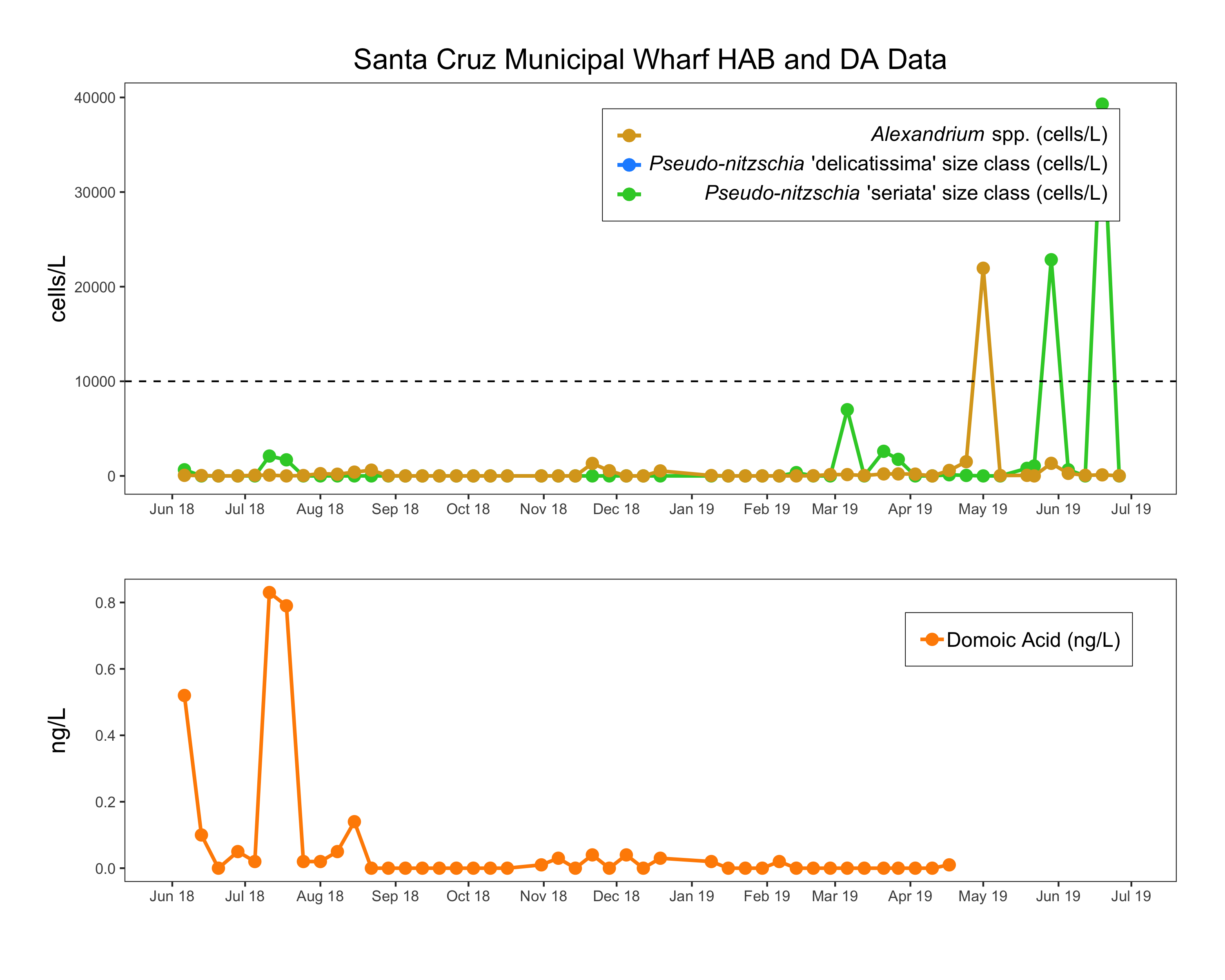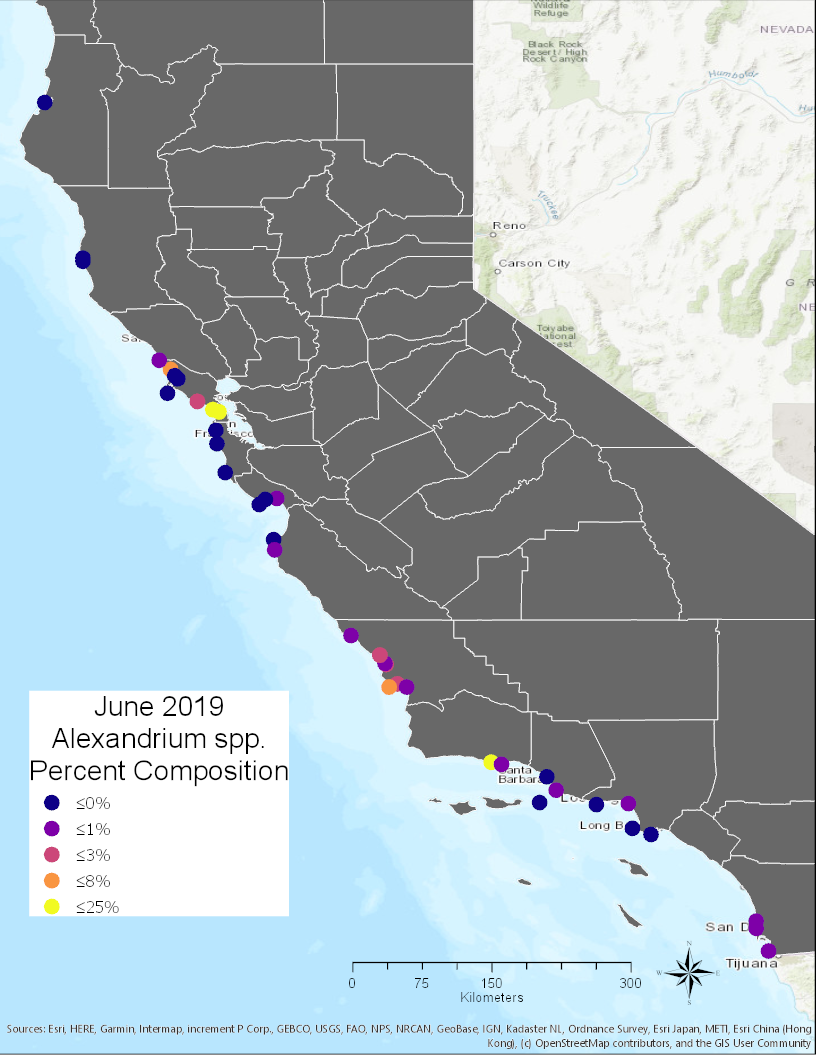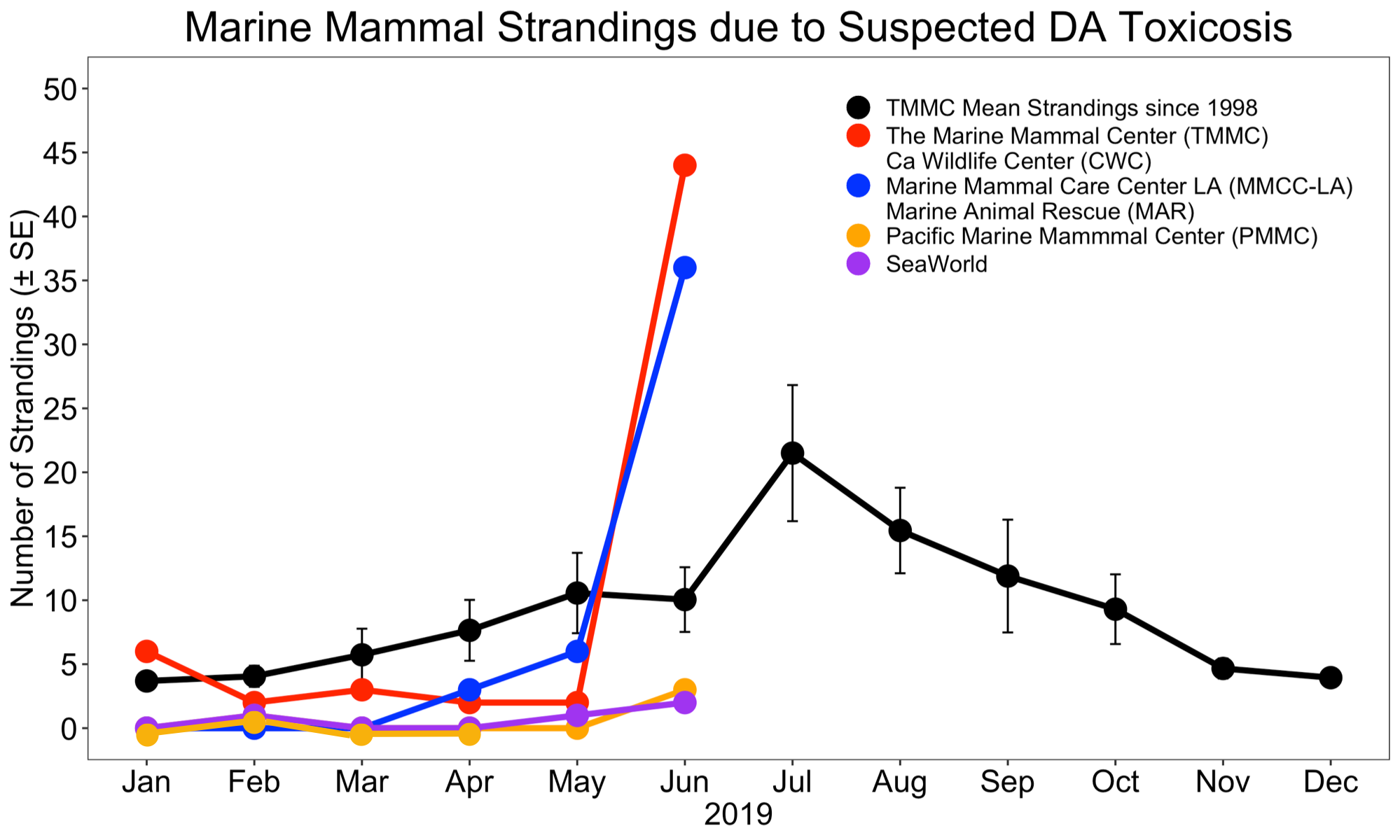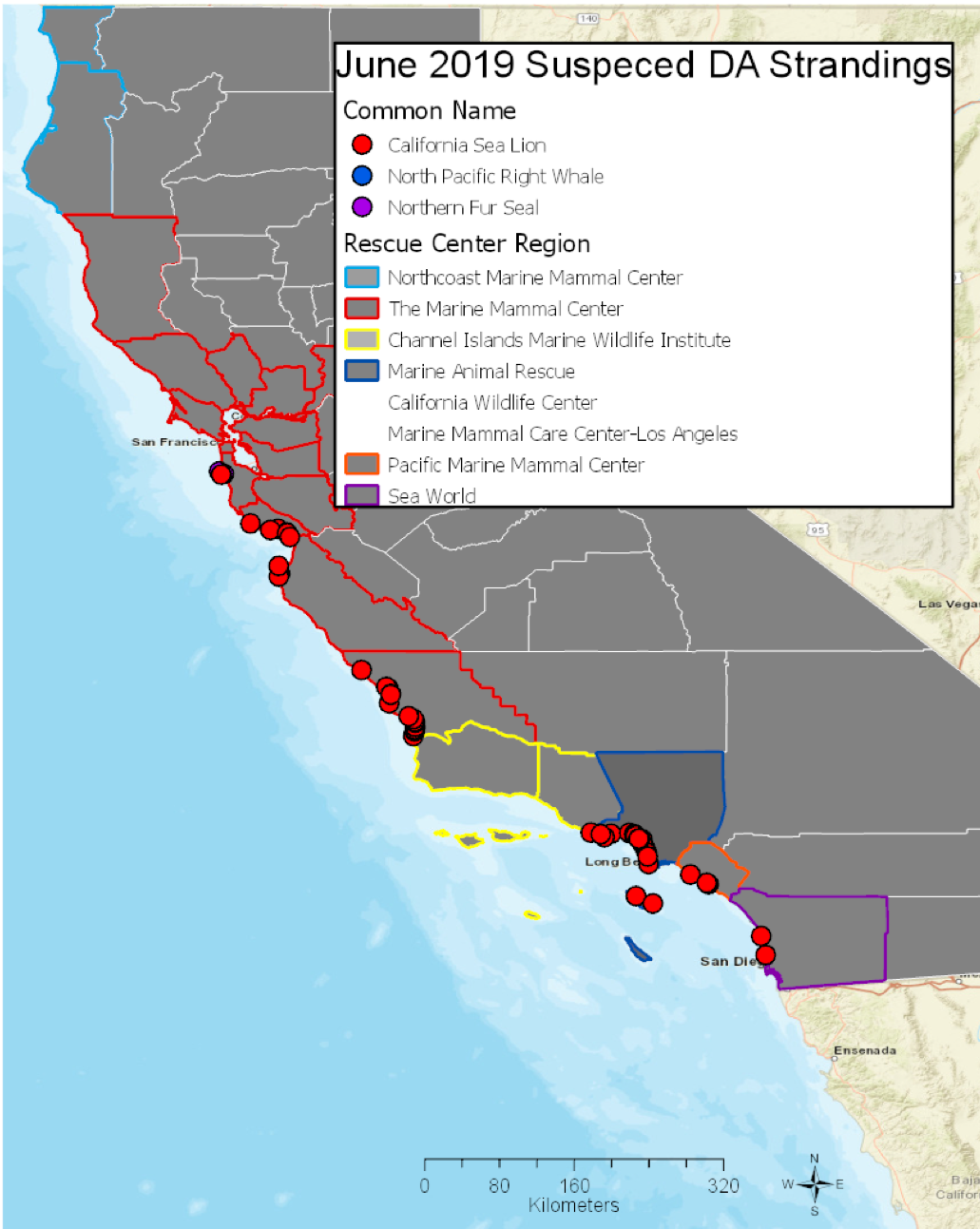Pseudo-nitzschia and Domoic Acid Predictions - C-HARM tells us where conditions are suitable for Pseudo-nitzschia spp. (all size classes) to grow well and where they might be more likely to produce domoic acid (DA). In early June, suitable habitat for Pseudo-nitzschia spp. was spread throughout coastal California with some retraction in the Southern California Bight later into the month. C-HARM predicted high pDA in offshore central California water, particularly in the middle of the month, and along the Humboldt and Sonoma coastlines and throughout the Southern California Bight over the course of June. C-HARM also indicates very high probabilities in cDA distributed in patches along the Humboldt and Sonoma coastline and shift from high cDA to low cDA in the Bight over the course of June. This pattern is reflected in the HABMAP measurements at the piers. Bloom levels of Pseudo-nitzschia seriata size class were sustained at Santa Cruz Wharf in two pulses in early and late June. Bloom levels of both P. seriata and delicatissima size classes rose and fell fairly abruptly at central and southern CA piers, consistent with the C-HARM retraction in pDA and cDA in the Southern California Bight. Currently available measurements of DA at the HABMAP pier sites point to abrupt increases in nearshore DA in central CA (Cal Poly Pier) and a gradual increase at Newport Beach Pier from early to mid-June. In general, animal strandings related to DA were very high in central and southern California throughout June with most animals presenting with DA symptoms. Interestingly, despite the major spike in sea lion strandings from apparent DA toxicosis in the LA area, DA levels at Santa Monica Pier were low (or zero) in early June, with later results still forthcoming. CDPH recorded its highest levels of Pseudo-nitzschia spp. abundance at Santa Monica Pier.
Alexandrium - HABMAP records for Alexandrium spp. at pier sites indicate bloom levels at Cal Poly Pier, while CDPH recorded its highest relative abundance of Alexandrium spp. at Goleta Pier in the Santa Barbara Channel region. These observations are consistent with CDPH shellfish advisories for PSP in San Luis Obispo and Santa Barbara Counties in June.

HABMAP Monitoring Sites
Note that data for some stations are not shown because they are not yet recorded in the public HABMAP archive.
Differentiating Pseudo-nitzschia species by light microscopy is difficult. For this reason, Pseudo-nitzschia "seriata" does not refer to an actual species but rather the larger size class of Pseudo-nitzschia, which is generally a more toxigenic group of species. Alternatively, Pseudo-nitzschia "delicatissima" refers to the smaller size class that is generally non-toxigenic. The dashed line on the plots demarcates the 10,000 cells/L "bloom" threshold designated here for Pseudo-nitzschia populations only.
Monterey Wharf
Monterey Wharf water samples are not yet available for the month of June.
Cal Poly Pier
Water samples were collected at Cal Poly Pier five times in the month of June. Pseudo-nitzschia delicatissima group was detected above bloom levels on June 2nd and 9th and Pseudo-nitzschia seriata group was detected below bloom levels on June 16th. Alexandrium spp. were detected above blooms levels in three of the five samples - June 9th, 16th and 30th. Domoic Acid results are not yet available for the month of June.
Stearns Wharf
Water samples were collected at Stearns Wharf four times in the month of May. Pseudo-nitzschia delicatissima group and Pseudo-nitzschia seriata group were detected above bloom levels throughout the month of May and Alexandrium spp. were detected above bloom levels on May 7th and 13th. Domoic Acid results are not yet available for the month of June.
Santa Monica Pier
Water samples were collected at Santa Monica four times in the month of June. Pseudo-nitzschia delicatissima group and Pseudo-nitzschia seriata group were detected above bloom levels on June 3rd. Alexandrium spp. were not detected in any of June water samples. Domoic Acid results are not yet available for the month of June.
Newport Beach Pier
Water samples were collected at Newport Beach Pier four times in the month of June. Pseudo-nitzschia delicatissima group and Pseudo-nitzschia seriata group were detected above bloom levels on June 3rd and Alexandrium spp. were not detected in any of the samples. Domoic Acid was not detected in any of samples in the month of June.
Scripps Pier
Scripps Pier Pseudo-nitzschia spp., Alexandrium spp., and domoic acid results are not yet available at this time.
CDPH observations for Pseudo-nitzschia spp. and Alexandrium spp.
From 1-30 June 2019, water samples were collected by volunteers and sent to the California Department of Public Health (CDPH) for analysis. Pseudo-nitzschia spp. was detected in 34 of the 55 samples. Pseudo-nitzschia spp. was recorded at Common density levels in five of the samples:
- June 29th at Santa Monica Pier (20% composition)
- June 19th at Santa Cruz Pier (15% composition)
- June 23rd at Tomales Bay (10% composition)
- June 13th at San Simeon Pier (10% composition)
- June 18th Pacific Beach Pier (10% composition)
Alexandrium spp. were detected in 21 of 38 samples in the month of June with the highest percent composition of 25% on June 4th at Goleta Pier and 15% composition on June 14th at Rodeo Beach and June 11th at Presidio Pier in San Francisco. You can also view CDPH weekly map layers of Pseudo-nitzschia and Alexandrium here.
Data are provided by the California Department of Public Health, Environmental Management Branch.
CDPH and OEHHA Health Advisories
The California Department of Public Health (CDPH) issued a health advisory on June 21st and June 27th to not eat sport-harvested mussels, clams or scallops in Marin County and Sonoma County due to PSP toxins. The safety notification is in addition to the annual mussel quarantine starting May 1st. On June 7th, CDPH also released a shellfish safety notification for sport-harvest bivalve shellfish from San Luis Obispo and Santa Barbara Counties due to dangerous levels of paralytic shellfish poisoning (PSP) toxins detected in mussels.
The safety notification for Sonoma, Marin, and Santa Barbara Counties was lifted on July 23rd, 2019.
For the latest closures and updates, please visit the CDFW Health Advisories page as a central location of information related to CDPH and/or OEHHA health advisories.
Domoic acid (DA) is a potent neurotoxin produced by some diatom species of the genus Pseudo-nitzschia. Species exposed to DA can result in seizures, epilepsy, cardiomyopathy, and death depending upon the ingested dose. DA toxicosis commonly occurs in California Sea Lions (Zalophus californianus), presumably due to a combination of foraging behavior and seasonal movements. The Marine Mammal Center (TMMC), the California Wildlife Center (CWC), the Marine Mammal Care Center Los Angeles (MMCC-LA), Marine Animal Rescue (MAR), the Pacific Marine Mammal Center (PMMC), and SeaWorld act like an emergency room by working to rescue and rehabilitate sick and injured marine mammals, seabirds, and sea turtles.
Among all the rehabilitation centers a total of 85 marine mammal strandings presented with symptoms of domoic acid toxicosis in the month of June with 36 in Los Angeles and 31 California Sea Lions in San Luis Obispo counties.
At this time we do not have data from the North Coast Marine Mammal Center or the Channel Islands Marine Wildlife Institute.
June marine mammal strandings suspected due to DA toxicosis occurred in the following counties:
- San Mateo - 3 (TMMC)
- Santa Cruz - 7 (TMMC)
- Monterey - 3 (TMMC)
- San Luis Obispo - 31 (TMMC)
- Los Angeles - 36 (CWC, MMCC-LA, MAR)
- Orange County - 3 (PMMC)
- San Diego - 2 (SeaWorld)
California Sea bird Strandings from suspected DA Toxicosis
Data coming soon from Wildlife Rehabilitation Medical Database (WRMD) and BeachCOMBERS.
















